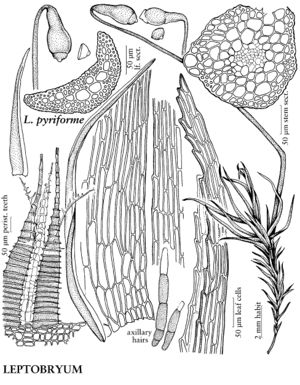Leptobryum
Bryol. Brit., 219. 1855.
| Taxon | Illustrator ⠉ | |
|---|---|---|
 | Leptobryum pyriforme | Patricia M. Eckel |
Leaves flexuose, erect, or widespreading, not 3-ranked, long-lanceolate to linear; margins plane; laminal cells long-rectangular, surface not bulging-conic, smooth, walls firm, moderately thick; basal-cells shorter, somewhat wider than distal cells.
Distribution
North America, Mexico, West Indies, Central America (Guatemala), South America, Eurasia, Pacific Islands, Australia (Tasmania)
Discussion
Species ca. 10 (1 in the flora).
According to V. I. Zolotov and M. S. Ignatov (2001), axillary hair morphology (clublike shape, only the terminal cells hyaline, and basal cells strongly pigmented) and recent molecular phylogenetic analyses place Leptobryum in Meesiaceae. There is also some resemblance in general morphology, particularly the long setae and pyriform, nodding capsules. However, the peristome of Leptobryum is not reduced as is often the case in Meesiaceae, and the disturbed habitat and long, setaceous leaves with narrowly rectangular distal laminal cells are particularly anomalous. Although a phylogenetic relationship among the genera is probable, Leptobryum may warrant a separate family to flag the significant evolutionary differences.
Selected References
None.